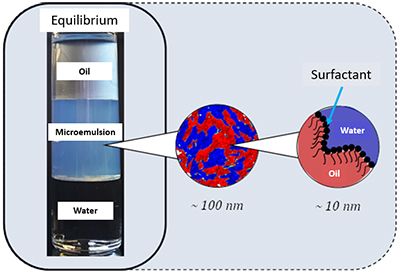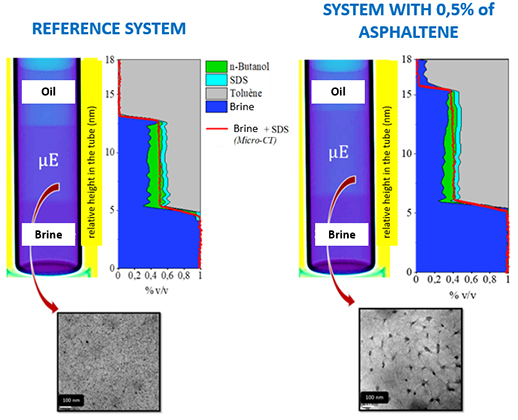Thesis prepared by Delphine Herrera: "Characterization and kinetic studies of the formation of bicontinuous microemulsions - Impact of asphaltenes"
In the context of the energy transition, it is expected that oil production will decrease at the same pace as the development of low-carbon energies and people’s evolving needs in this area.
During this transition, it appears to be far more pertinent to seek to extract more oil from existing fields rather than to bring new fields into production.
Hence the importance attached to enhanced oil recovery or EOR. This practice consists, for example, in injecting aqueous surfactant solutions that will enable the formation of microemulsions, thereby eliminating the capillary forces opposing flows in the porous media of the reservoir. These thermodynamically stable microemulsions take the form of bicontinuous mixtures (Figure 1).

The formulation of solutions to be injected is chosen in such a way as to maximize the mobilization of hydrocarbons trapped in the reservoir rock. The choice is made in the laboratory on the basis of criteria relating to the stability of the microemulsions formed and interfacial stresses. However, when conducting tests with real crude oils, the visualization of the microemulson tends to be challenging due to its opacity and its poorly defined interfaces with the excess aqueous and oil phases. Researchers are thus faced with a number of difficulties when trying to characterize the target properties and ensure they have before them a genuine thermodynamically stable microemulsion system. Moreover, few approaches provide access to the formation kinetics relating to these complex systems, especially in reservoir conditions.
It is therefore necessary to conduct these tests on microemulsions that are based on model oils, supposedly equivalent to the crude to be extracteda. However, the question of how representative the microemulsions formed are compared to actual cases arises, in the absence of surfactants, particularly asphaltenes, which are naturally present in hydrocarbons. Moreover, this difference in composition means it is not possible to guarantee the microemulsion formation kinetics are similar to those that would actually be produced following injection into the reservoir.
In order to make progress in the characterization of complex microemulsions and the understanding of factors influencing their formation, a PhD thesis was undertaken adopting a multi-scale approach, from interface structures (on a nanometric scale) through to the global behavior of the microemulsion.
The research initially focused on the development and implementation of non-destructive characterization methods - NMR, Microscanner, SAXS and DLSb - aimed at gaining a better understanding of the mechanisms involved in the formation of model and asphaltene microemulsions.
In terms of methodology, a new NMR application was specifically developed for this study and good agreement was found with another original X-ray tomography approach [1]. NMR is one of the few methods adapted to opaque or dark systems for the determination of the compositions of the different phases simultaneously, rapidly and locally. A result example is shown in Figure 2.

The images present the structure of the microemulsion obtained by cryo-TEM.
The second part of the research involved studying the impact of the presence of asphaltenes on the microemulsion structure further using a combination of techniques: X-ray and neutron scattering (SAXS/SANS), cryo electronic microscopy by transmission (cryo-TEM), DSCd microcalorimetry and interfacial rheology measurements using the oscillatory spinning drop method.
In the absence of agitation, and in the presence or otherwise of asphaltenes, the comparison of the results obtained highlighted the transient presence of a semi-crystalline phase during microemulsion formation [2]. In addition, the presence of asphaltenes results in a macroscopic swelling of the bicontinuous phases of the systems observed, a phenomenon that was shown to be correlated with an increase in the size of the microemulsion domains on a microscopic scale. The characteristics of the interfacial film were also determined and appear to indicate that asphaltenes have a significant impact both on its rigidity and also, on a broader scale, on its rheological properties.
A result of significant interest concerning the efficiency of the EOR process is that the presence of asphaltenes does not alter the bicontinuous nature of the microemulsion formed, a key parameter of the process, but simply results in the presence of water in the excess oil phase.
In addition to providing a better understanding of the mechanisms relating to microemulsion formation, this PhD research provided a new experimental methodology, based on a set of robust and complementary techniques, to improve the characterization of their behavior. This advance could be extended to other application contexts involving microemulsions: reaction processes, extraction processes or nanoparticle synthesis.
a- Presenting the same number of carbon atoms
b- NMR: Nuclear Magnetic Resonance, SAXS (Small Angle X-rays Scattering) and DLS (Dynamic Light Scattering)
c- Sodium Dodecyl Sulfate
d- DSC (Differential Scanning Calorimetry).
Bibliographic references:
- D Herrera, T Chevalier, M Fleury, C Dalmazzone, "Quantification of microemulsion systems using low-field T1-weighted imaging", Magnetic Resonance, Imaging 83 (2021) 160–168.
>> https://doi.org/10.1016/j.mri.2021.08.002
- D Herrera, T Chevalier, D.Frot, L Barré, A Drelich, I Pezron, C Dalmazzone, "Monitoring the formation kinetics of a bicontinuous microemulsion", Journal of Colloid and Interface Science 609 (2022) 200–211.
>> https://doi.org/10.1016/j.jcis.2021.12.011
Scientific contacts: Christine Dalmazzone ; Thibaud Chevalier





